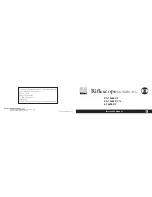
NOTE:
For a list of
magnification ratings
of the eyepieces
available for the LX90
telescope, see
OPTIONAL
ACCESSORIES
,
page 42.
NEVER point the
telescope directly at
or near the Sun at any
time! Observing the
Sun, even for the
smallest fraction of a
second, will result in
instant and
irreversible eye
damage, as well as
physical damage to
the telescope itself.
14
4.
Remove the dust cap from the rear cell of the telescope. Thread the eyepiece holder into
the rear cell thread. Slide the diagonal prism into the eyepiece holder and lock in place by
turning the thumbscrew to a firm feel.
5.
Remove the Super Plössl 26mm eyepiece (
Pg. 7, Fig. 1, 1
) from its container and place it
in the diagonal prism (
Pg. 7, Fig. 1, 3
). Tighten the thumbscrew (
Pg. 7, Fig. 1, 2
) to a firm
feel only.
6.
Remove the dust cover (
Pg. 7, Fig. 1, 15
) from the optical tube assembly (
Pg. 7, Fig. 1, 5
)
by gently prying it off.
Choosing an Eyepiece
A telescope’s eyepiece magnifies the image formed by the telescope’s main optics. Each
eyepiece has a focal length, expressed in millimeters, or “mm”. The smaller the focal length, the
higher the magnification. For example, an eyepiece with a focal length of 9mm has a higher
magnification than an eyepiece with a focal length of 26mm.
Your telescope comes supplied with a Super Plössl 26mm eyepiece, which gives a wide,
comfortable field of view with high image resolution.
Low power eyepieces offer a wide field of view, bright, high-contrast images, and eye relief
during long observing sessions. To find an object with a telescope, always start with a lower
power eyepiece such as the Super Plössl 26mm. When the object is located and centered in
the eyepiece, you may wish to switch to a higher power eyepiece to enlarge the image as much
as practical for prevailing seeing conditions. For information about optional eyepieces for the
LX90, see
OPTIONAL ACCESSORIES
, page 42.
NOTE:
Seeing conditions vary widely from night-to-night and site-to-site. Turbulence
in the air, even on an apparently clear night, can distort images. If an image appears
fuzzy and ill-defined, back off to a lower power eyepiece for a more well-resolved
image (
Pg. 16, Fig. 7
).
The power or magnification of a telescope is determined by the focal length of the telescope
and the focal length of the eyepiece being used. To calculate eyepiece power, divide the
telescope's focal length by the eyepiece's focal length. For example, a 26mm eyepiece is
supplied with the LX90. The focal length of the 8” LX90 is 2000mm (see
SPECIFICATIONS
,
page 47).
Telescope Focal Length
2000mm
Eyepiece Focal Length
26mm
2000 ÷ 26 = 77mm
The eyepiece power, or magnification, is therefore 77X.
Содержание LX90-ACF Advanced Coma-Free
Страница 57: ...OBSERVATION LOG 57...
Страница 58: ...58 OBSERVATION LOG...
Страница 59: ...59 OBSERVATION LOG...









































